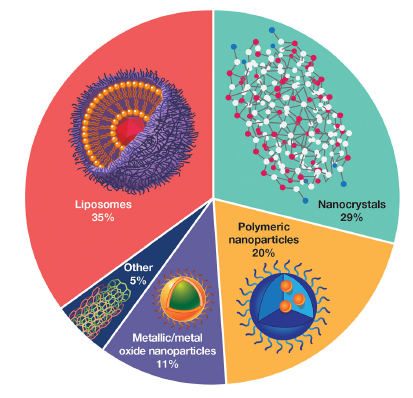Summary
Advances in methods, instrumentation and standards promote the development of measurement science capabilities in separation technology and physical-chemical analysis to address stakeholder needs and enable innovation in the emerging field of nanomedicine.
Description

Most common nanomaterial-containing drug classes submitted to FDA.
Drug products that incorporate nanomaterials are defined by FDA as non-biological complex drugs (NBCDs). NBCDs are a class of medical products that cannot be defined nor fully identified as traditional small-molecule drugs. NBCDs consist of different components that form a complex hybrid structure that challenges existing pharmaceutical methods of analysis. Examples include iron-carbohydrate complexes for treatment of iron-deficient anemia and liposomal chemotherapy delivery systems. The complex nature of NBCDs means that small variations in the manufacturing process can substantially alter the composition, efficacy, and safety of final products. This in turn poses a challenge for the development of regulatory guidelines and the evaluation of equivalency for generic products (i.e., similars).
This project addresses the need for reliable and accurate measurements to establish the critical physical and chemical characteristics of NBCDs containing nanoscale materials. Research focuses on development of new and novel methods and instrumentation, documentary standards and reference or test materials supporting the preclinical development, translation and regulatory oversight of novel NBCDs. This project also addresses the lack of robust separation and measurement methods for nanoparticles of biological origin, such as extracellular vesicles (EVs). EVs are nanoscale lipid bilayer structures thought to play a role in intercellular communication and currently of substantial interest for their potential exploitation as disease markers. They share many of the complexities associated with NBCDs coupled with their biological source and their co-existence with other biological materials.
A key component of this project has been the development of hyphenated (tandem) measurement technologies and methods (e.g., asymmetrical-flow field-flow fractionation combined with multi-detector analysis and a temperature-controlled automated fraction collector for off-line analysis). Two state-of-the-art A4F systems are available, with on-line UV-Vis diode array detectors, differential refractometry, fluorescence detectors, multi-angle light scattering, quasi-elastic light scattering and ICP-MS. Electrospray ion mobility analysis coupled with ICP-MS is a novel aerosol-based approach developed in our labs and complementary to AF4.
The project includes external collaborations with multiple stakeholders across US and international institutes, pharma-industry and regulatory agencies, in addition to standards development organizations such as ASTM International and ISO.
NRC RESEARCH OPPORTUNITIES
Metrology for Nanomaterial-Based Non-Biological Complex Drugs

